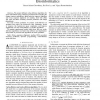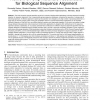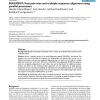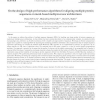118
Voted
BMCBI
2011
14 years 7 months ago
2011
Background: We present a novel method to encode ambiguously aligned regions in fixed multiple sequence alignments by ‘Pairwise Identity and Cost Scores Ordination’ (PICS-Ord)....
137
Voted
BMCBI
2010
14 years 10 months ago
2010
Background: Traditional genome alignment methods consider sequence alignment as a variation of the string edit distance problem, and perform alignment by matching characters of th...
110
Voted
IPPS
2010
IEEE
14 years 10 months ago
2010
IEEE
The Smith-Waterman (SW) algorithm is one of the widely used algorithms for sequence alignment in computational biology. With the growing size of the sequence database, there is alw...
102
Voted
IMCSIT
2010
14 years 10 months ago
2010
Abstract--We present a method for improving existing statistical machine translation methods using an knowledge-base compiled from a bilingual corpus as well as sequence alignment ...
110
Voted
TCBB
2010
14 years 11 months ago
2010
— We present efficient cache-oblivious algorithms for some well-studied string problems in bioinformatics including the longest common subsequence, global pairwise sequence alig...
121
Voted
TC
2010
14 years 11 months ago
2010
—The most pervasive compute operation carried out in almost all bioinformatics applications is pairwise sequence homology detection (or sequence alignment). Due to exponentially ...
97
Voted
JCB
2000
15 years 10 days ago
2000
We study the problem of similarity detection by sequence alignment with gaps, using a recently established theoretical framework based on the morphology of alignment paths. Alignm...
131
Voted
BMCBI
2004
15 years 12 days ago
2004
Background: Parallel computing is frequently used to speed up computationally expensive tasks in Bioinformatics. Results: Herein, a parallel version of the multi-alignment program...
111
Voted
JPDC
2007
15 years 13 days ago
2007
In this paper, we address the problem of multiple sequence alignment (MSA) for handling very large number of proteins sequences on mesh-based multiprocessor architectures. As the ...
103
Voted
BMCBI
2005
15 years 13 days ago
2005
Background: Exhaustive methods of sequence alignment are accurate but slow, whereas heuristic approaches run quickly, but their complexity makes them more difficult to implement. ...




